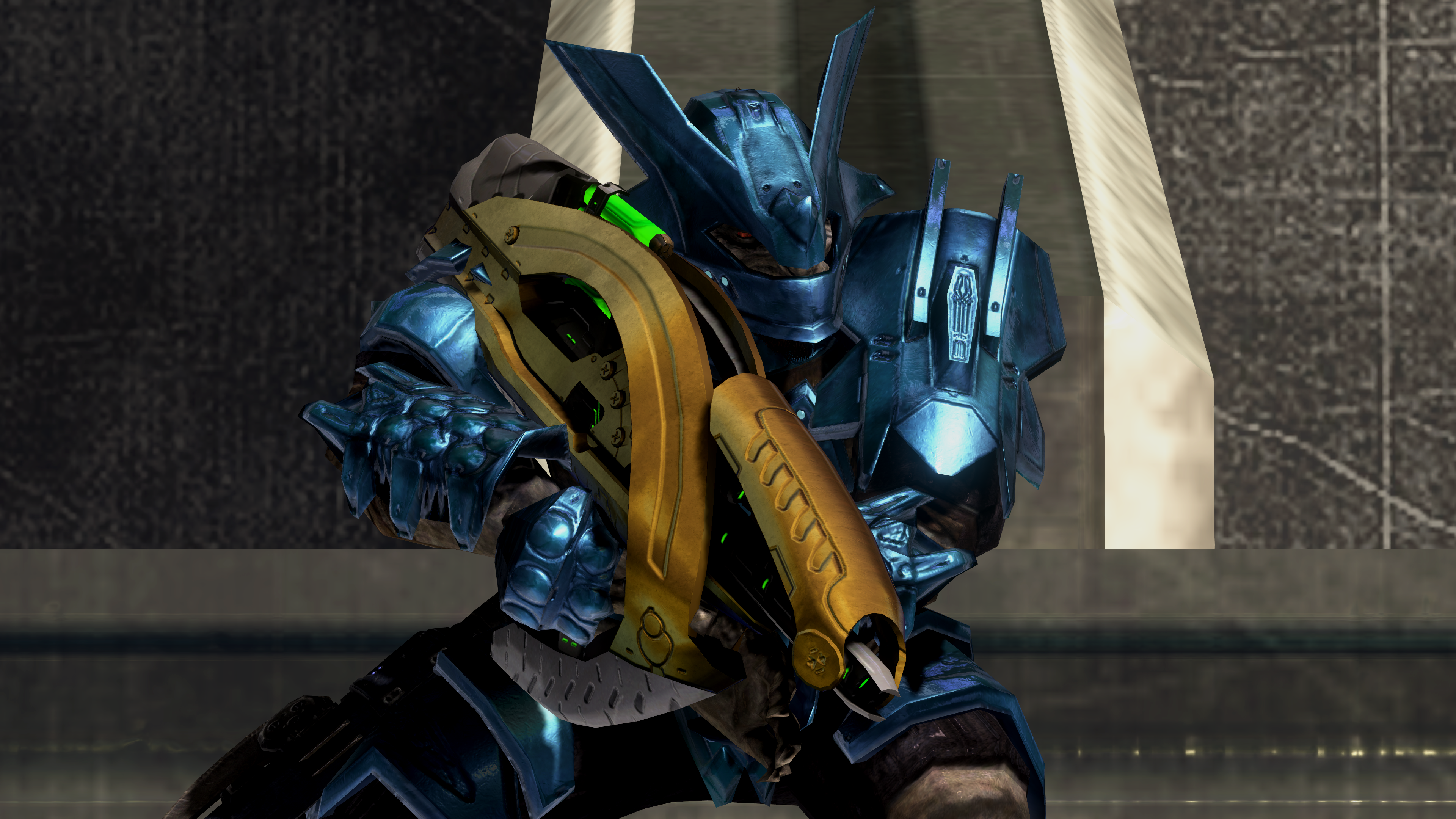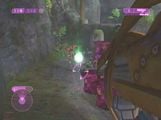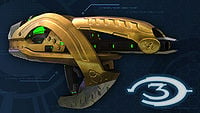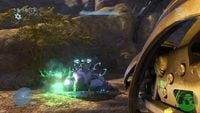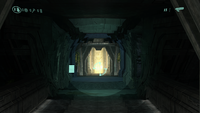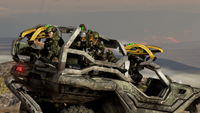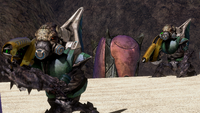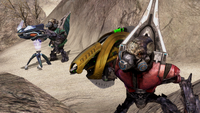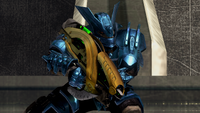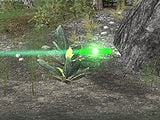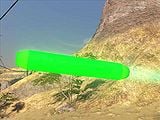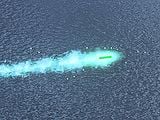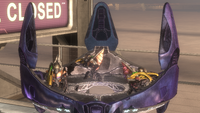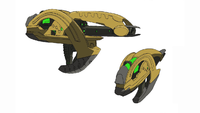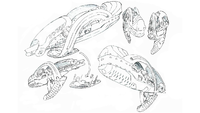Pez'tk-pattern fuel rod gun
From Halopedia, the Halo wiki
| Pez'tk-pattern Flak Launcher | |
|---|---|
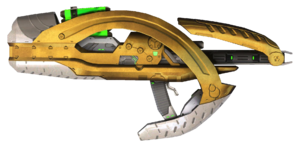
| |
| Production overview | |
|
Manufacturer: |
Merchants of Qikost (Post-war)[1] |
|
Type: |
|
| Specifications | |
|
Length: |
|
|
Weight: |
|
|
Ammunition type: |
32 millimeters (1.3 in) Class-2 fuel rod[1][3] |
|
Capacity: |
|
|
72 m/s (236 ft/s)[2] | |
|
Optics: |
2× magnification[1] |
|
Effective range: |
|
| Service history | |
|
In service: |
|
- "Those things are scary as hell. Ya hear that weird “whump” sound and even if ya see it comin' you're transfixed, these big green blobs flying at you throwin’ off sparks!"
- — Anonymous E2-BAG/1/7 Marine[2]
The Pez'tk-pattern Flak Launcher[1] (UNSC Type classification: Type-33 Light Anti-Armor Weapon, T-33 LAAW)[2][3] is a model of fuel rod gun used by the Covenant and its remnants. They were developed by the Covenant as an alteration of the design with improved ergonomics intended for use by Unggoy operators and an aesthetic more appealing to San'Shyuum bureaucrats. As such, the design is generally looked upon with distaste by the Sangheili (who developed the original fuel rod guns), who typically prefer other models.[1]
Overview[edit]
Design details[edit]
The Pez'tk is an altered design of fuel rod gun intended for use by Unggoy operators. It features enhanced ergonomics for their use, alongside aesthetics intended to appeal more toward the tastes of the San'Shyuum munitions-cyphers who designed it. These preferences were engineered at the expanse of the weapon's performance characteristics, making them unpopular with the Sangheili.[1] The weapon has a bulky gold housing that has the curvilinear forms characteristic of Covenant architecture. Its ammunition, a clip of five 32 millimeters (1.3 in) Class-2 fuel rods, is inserted into the weapon via a port on the top, similar to other Covenant-era fuel rods like the Korva-pattern and Zasqi-pattern. The fuel rods are fed into a barrel which measures 73.66 centimeters (29.00 in) in length,[2] and appears to recoil separately to the rest of the weapon when fired.
Fuel rod guns were initially encountered by the United Nations Space Command in 2531, though were not type-classified until the year of 2533, giving rise to the weapon's Type-33 designation. The report "Machines, Materiel and Munitions from the Human-Covenant Conflict, 2525 - Present" describes early fuel rod examples as having been encountered with a "dead man's switch" that would self-destruct the weapon when its operator was killed; it is unclear whether the report was referring to the Zasqi-pattern which often fielded with such systems, or whether Pez'tk fuel rods were also fielded with them.[Note 1] Either way, these systems fell out of favour towards the end of 2552.[2]
UNSC remarks[edit]
- “Those things are scary as hell. Ya hear that weird “whump” sound and even if ya see it comin' you're transfixed—these big green blobs flying at you throwin’ off sparks!”
- “It’s so weird. I don’t know who first called it a fuel rod gun, but it’s kinda funny. I suppose the projectile is reminiscent of how you might expect to see a nuclear fuel rod depicted in a GA cartoon—all glowing green and throwing off sparks.”
- “They’re pretty tricky to handle—first off you gotta get over the fact that there is this glowing, green explosive whatever right next to your head; and it’s not like you can requisition any more ammo for the damn thing—but you can lay down a whole lotta hurt in a very short amount of time I’ll tell you that.”
- “The Type-33s have more in common with the ballistic weapon on the Banshee than it does with the weapon that the Hunters carry around—well, not carry around, but you know what I mean.”
- “I catch a glimpse of green out of the corner of my eye and then there’s this huge “whoomf” and the ‘Hog goes end over end burning with Gaz still at the wheel. I was riding shotty with the M41 so I just unlatched and pushed off when we started going up into the air and there went the ‘Hog and Gaz and all our gear cart-wheeling into the ravine.”
- “No sooner had I put the Grunt down than Fisk has got a hold of that bad boy and dumps the whole clip into the column—stickies and everything just cooking off—secondaries like mad! Fisk was a crazy bastard he was—wish he was still with us.”
In-game information[edit]
- Main article: Fuel Rod Gun (gameplay)
The Pez'tk fuel rod gun was first introduced into the Halo games in Halo 2, replacing the Zasqi-pattern design featured in Halo: Combat Evolved. Unlike its predecessor, the Pez'tk is a magazine-fed weapon that does not overheat, and does not fire its rounds on as pronounced a parabolic arc. The weapon was adopted in Halo 3 and Halo 3: ODST in a similar role, before being replaced in Halo: Reach and future titles with the Korva-pattern.
Production notes[edit]
- Main article: Cut Halo: Combat Evolved weapons § Flak cannon
The Pez'tk's design is broadly inspired by the Flak Cannon developed during the production of Halo: Combat Evolved. During the game's production there were two Covenant launcher concepts fielded in early builds of the game: the Flak Cannon and Fuel Rod Gun. While the Fuel Rod Gun's design was ultimately featured in Combat Evolved as the Zasqi-pattern fuel rod gun, Bungie chose to redesign the Fuel Rod Gun for Halo 2 with much inspiration taken from the Flak Cannon. This inspiration can be mostly seen in the main body of the weapon, though with the original Fuel Rod Gun's aft and magazine.
Trivia[edit]

|
See our gameplay information related to Pez'tk-pattern fuel rod gun on its gameplay page. |

|
Browse more images in this article's gallery page. |
- The fuel rod gun is the only weapon in the trilogy which has a separate animation and timer when throwing a grenade; there is approximately a 0.5 second longer delay before you throw the grenade.
- When the player gives a fuel rod gun to a marine, their animation is the same as if they were holding a rocket launcher; their left hand is at an angle, just like when they hold a rocket launcher.
- When an NPC is holding the weapon since Halo 2 and Halo 3 the projectiles will have a rather strong homing towards the objective, however when the player uses it, it will lack said feature.[4]
Gallery[edit]
A Sangheili Ultra takes cover while holding a fuel rod gun in Halo 2.
Marines carrying fuel rod guns on an M831 Troop Transport Warthog in Halo 3.
Unggoy Heavy carrying fuel rod guns in Halo 3.
An Unggoy Major with a fuel rod gun in Halo 3.
A Sangheili firing a fuel rod gun at Yanme'e during the Battle of Installation 00.
List of appearances[edit]
- Halo 2 (First appearance)
- Halo: Ghosts of Onyx
- Halo: Uprising
- Halo 3
- Halo: Helljumper
- Halo 3: ODST
- Halo Legends
- Halo: Evolutions - Essential Tales of the Halo Universe
- Halo: Blood Line
Notes[edit]
- ^ While the original article was almost certainly presenting an in-universe justification for the difference in fuel rod behaviour seen in Halo: Combat Evolved versus Halo 2/Halo 3, the later splitting of the individual design patterns means the report's in-universe context is now unclear.
Sources[edit]
- ^ a b c d e f g Halo Encyclopedia (2022 edition), page 299
- ^ a b c d e f g h i j k Bungie.net, Type-33 Light Anti-Armor Weapon (Retrieved on Jan 31, 2021) [local archive] [external archive]
- ^ a b c d e Halo Encyclopedia (2009 edition), page 325
- ^ r/halo, Fun Fact: in Halo 3, when the ai use a Fuel Rod it will have a very slight homing on targets which causes it to curve towards an enemy they're shooting at (Retrieved on Apr 12, 2025) [archive]
| |||||||||||||||||||||||
